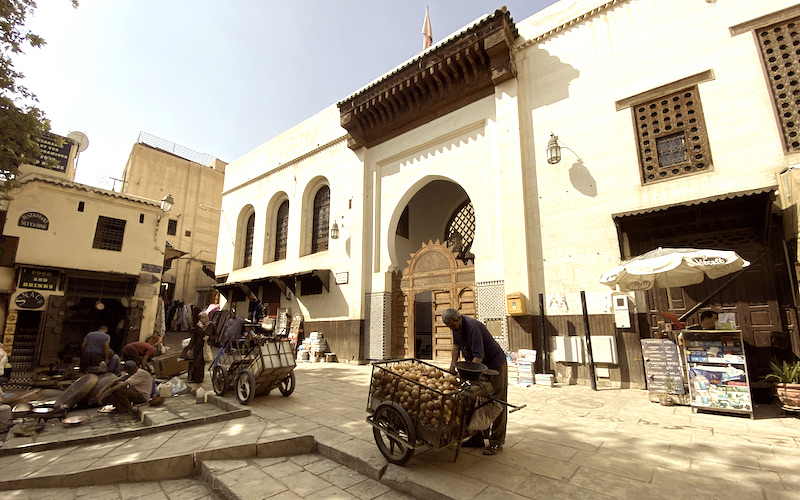If you are preparing a trip to Fez, you have probably heard or read about the Karaouiyine complex.
Fatima Al-Fihria, a wealthy heiress of Kairouan in Tunisia dedicated her inheritage to the worshipers of the city of Fez. Therefore, she mandated the construction of the Karaouiyine estate in the 9th century.
More than a mosque, she wanted a whole complex dedicated to both islamic and secular studies. Hence a global estate composed of a mosque, a library and one of the oldest university in the world along with the university of Bologna in Italy.
THE KARAOUIYINE MOSQUE
The Karouiyin mosque is a must-see monument in the Fez medina. From almost all terraces of the medina you will be able to see its endless green tile roofs and its small white minaret surmounted by a dome, sober and modest.
Learn more about the history of the Karaouiyine Mosque and follow the wanderings of my first visit at the Karaouiyine, 15 years ago.
THE KARAOUIYINE UNIVERSITY: 12 CENTURY OF KNOWLEDGE
Built about twelve centuries ago, the Karaouiyine provided classes in theology, law, philosophy, mathematics, astrology-astronomy and language sciences, for boys only.
Here have sat the greatest intellectual, religious and literarture figures of the Arab world. Doctor and scientist Ibn Rochd (Averroes), Jewish philosopher Maimonides, or the illustrious historian and philosopher, Ibn Khaldun, are the most preeminent. Yet, important figures from the Western world have also been trained at the Karaouiyine, which is still considered as the oldest active university in the world. For example, Pope Sylvester II (999-1003) attended classes in Fez.
But beyond the fame of its students, in 1207, the University of Karaouiyine issued the oldest medical degree in the world. Named “Ijaza” (certificate or license), the diploma allowed Al Koutami to practice human and veterinary medicine. He is the oldest medicine student in the world.
The Karaouiyine University is still operating today. Yet courses are now held in buildings situated outside the medina. Studies are, nowadays, mostly oriented towards religion, literature, Islamic law and languages to a lesser extent.
The University stands on Seffarine Place, the noisiest place of the medina. In fact, hectic copper workers spend the day banging on copper pieces, converting them into saucepans, basins and cauldrons. Their activity there is not new. Actually, Leo the African, already attests of their presence in his writings from the 15th century.

Why on earth they have chosen this specific noisy activity to be located just opposite the door of a university library ? This still remains a mystery…
Discover the sound of banging at Seffarine.
THE TREASURES OF THE KARAOUYINE LIBRARY
Shelter for valuable scientific and historical testimonies
Some 40,000 scrolls, manuscripts and other documents have been collected in the Karaouiyine Library since its opening in the 9th century. Valuable works of scientific and historical reference. The library also shelters antic manuscripts saved from the burning of books, that occurred in Europe at the same period.
But, as incredible as it may sound, the Karaouiyine library is not opened to public. Worse, until very recently, these manuscripts were literally left to rotten, at the mercy of rats and water leaks.
Extensive réhabilitation program of the Karaouiyine Library
Yet, ten years ago, I was thrilled, when I learned that the library was to be restored. Intimately, things lasted and were delayed, until at last, they started the refurbishment work in 2014. For three years, the library has been restored and the books have been flashed on microfilms. However, the library is still closed to the public.
I tried many times to stop by the door and ask the door keeper. The answer is always the same… They are protecting the books and anyway, who would be interested in seeing these old books?… No need arguing. A donkey remains a donkey, even at the door of a library.
However, in 2017, just after the refurbishment of the library had been completed, Mayfez hosted a former Belgian Prime Minister. Thanks to the connexions of our tour guide, we managed to organize a private visit for VIP guest. Yet, if this guest hadn’t been who he was, he would probably never have had the privilege to enter the library.
Back at the riad, he told us about his excitement at this visit, although he was not shown the most emblematic books… I finally ended up wondering if the most emblematic manuscripts had not ended up in the stomach of a very knowledgeable bookworm…
In fact, the manuscripts do exist. But to see them, it was in Paris that you had to travel in spring 2017.
«Splendors of writing in Morocco, Rare and unpublished manuscripts»
This is how the exceptional exhibition held in spring 2017 at the Institut du Monde Arabe in Paris, was called.
Among the manuscripts on display could be found exceptional pieces, never seen by the public. All had been lent by the Royal Library of Morocco, the Library of the Quaraouiyine and the Library Ben Youssef.
These Moroccan manuscripts reflect the great tradition of books in Morocco and the importance of the Islam of the Enlightenment during the Middle Ages. Actually, Islam not only translated works from antiquity to the Middle Ages, but also contributed to the development of science.
Ultimately, the spiritual visit of Fez may well leave you with a bitter taste, unless you consider the spiritual transcendence of Fez, beyond the dogmatic inconsistencies. (lien vers l’artiche A la découverte de Fès la spirituelle)
Yet, if you consider that touching spirituality is not only about touching with your eyes and fingers, but on the contrary, about feeling deeply inside your brain and soul, then you may well find that peace and wisdom in the allweys of the Old medina of Fez,

